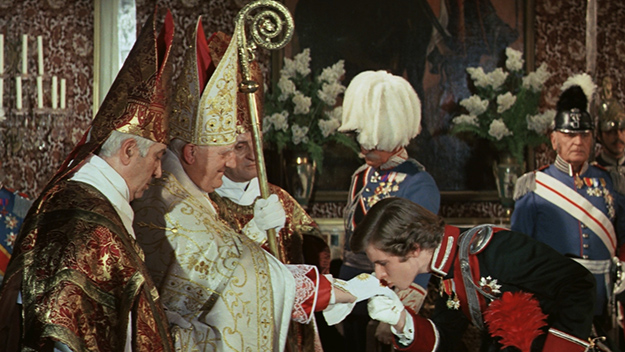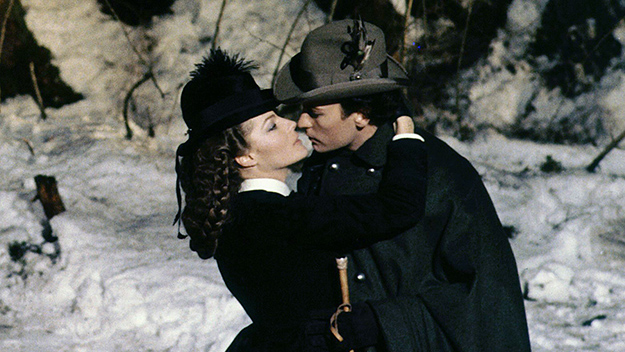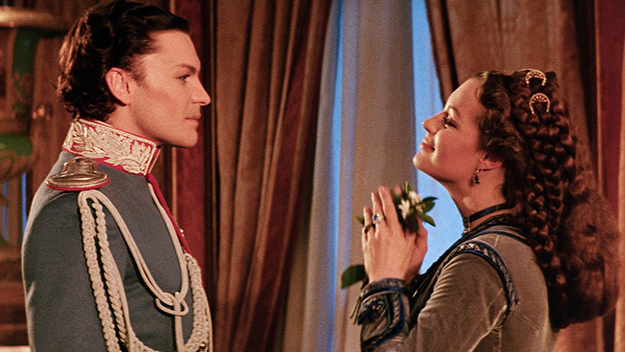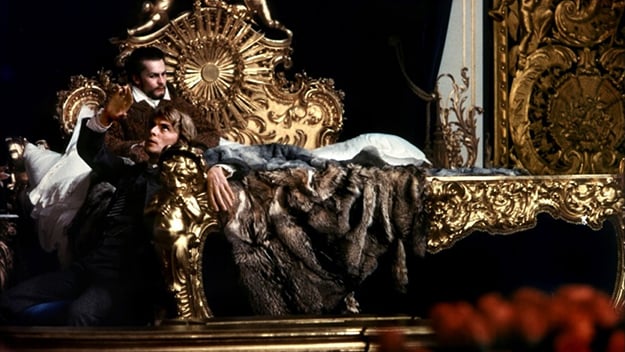Film of the Week: Ludwig

Luchino Visconti’s historical drama Ludwig is the sort of film that tends to be called a folly, but here the epithet isn’t altogether inappropriate. The film is certainly about folly—about an obsession which could be considered madness or be seen as a doomed idealism, striving for the absolute but fatally out of step with the realities of its age. The subject of this 1972 film—which can now be seen in a complete, 232-minute 35mm print as part of a Visconti retrospective at the Film Society of Lincoln Center—is Ludwig II, King of Bavaria from 1864 to 1886, and sometimes known as the “Mad King” or the “Swan King,” given his predilection for the iconography of Wagner’s operas.
Visconti’s film has not been much liked over the years, and even given the admiration that the director enjoyed at the time of its release—Death in Venice had triumphed in 1971—it was not much respected, either. Vincent Canby in the New York Times called Ludwig “opera buffa that doesn’t know it” and considered it “bereft of ideas,” while Roger Ebert in 1973 welcomed the fact that the film had been cut by 30 minutes since its New York premiere—and commented that, even so, “members of the audience were moved to whistle, yawn loudly and visit the water fountain.”
Let’s assume that in the ’70s, Ludwig was a film out of its time—sober yet lavishly appointed, forbiddingly old guard to the point of appearing laboriously academic. Today, it is still an anachronism—one can’t imagine a historical art film even again being made on such a lavish scale—and yet the very fact that it now seems so alien to us seems likely to give the film a new lease of life and attract a new audience more eager for this kind of measured pensiveness. That’s not to say that Ludwig has been revealed anew as a masterpiece: it can feel cumbersome, frustratingly disjointed, at times certainly a heavy watch. And yet this full-length Ludwig, originally shown in Venice in 1980, feels today like a painting whose images and forms can be at least freshly recognized.

The film follows Ludwig from his coronation to his death, immediately following his being deposed as King. His is a glorious career in some ways, a lamentable one in others. Whether or not Ludwig is mad per se, he is what his period might have called “nervous” or “neurasthenic”: he is an aesthete, of the kind who might have been happier enjoying the cultural and fleshly pleasures of his era’s Paris than living in the stuffy, ritual-bound world of middle-European monarchy. It is all the more stuffy in that the world of German monarchs is a closed family network. Ludwig’s cousin, with whom he is hopelessly in love from the start, is Empress Elisabeth of Austria (Romy Schneider), but there are other cousins, the Prussians, with whom Bavaria comes to be at war. “We keep everything in the family,” Ludwig says with disgust. “Wars, weddings, babies… We are incestuous and fratricidal.”
The fragile, self-absorbed Ludwig chooses to go into retreat, ignoring affairs of state entirely and acting as if his nation’s war were simply not happening; what he wants, he tells his trusted Colonel Durckheim (Helmut Griem), is “to reach for the happiness in the unreachable.” From the start of his career, Ludwig seeks that treasure in art, specifically in the operas of Richard Wagner, whom he takes on as financial protégé and as spiritual guru. But the composer goes a long way to bankrupting him, first with a spectacular production of Tristan and Isolde (not seen here), then with the construction of his opera house at Bayreuth (again not seen—and neither, for that matter, is the war which forms an all-important backdrop to Ludwig’s decline). His crowning folly, and a contributing factor in his downfall, is the exorbitantly fanciful and expensive series of castles he built, considered as the abusive excess of a narcissistic maniac, in defiance of all economic sense (although the Bavarian region has long been raking in plentiful tourist revenue from the castle of Neuschwanstein).
It’s also suggested, however, that Ludwig’s doom was partly to do with what enemies in his court here term his “eccentricity”—in other words, his homosexuality. He barely acknowledges it at first, nervously putting his cloak around a palace groom he sees bathing naked; then denies it when required by his priest to confess; but at last embraces it, staging private soirées of boys, booze, and lederhosen. The orgy scene toward the end was regarded on release as a something of a joke, given its lugubrious slowness and the fact that the participants end up dozing. We can now see the sequence, with its long-take painterly tableau of sleepers, with Ludwig pacing through the darkness and snow falling outside—all to the music of a gloomy accordion—as one of the film’s most gorgeously sorrowful moments.

Ludwig certainly presents a challenge: it offers us many images of imposing beauty and, increasingly, of strangeness. There are moments when you gasp—but there are also stretches where the film seems sluggish and oppressive, and that is partly a reflection of the heavy oppressiveness of Ludwig’s world, which he was so desperate to escape. His dream castles, however, themselves increasingly come to resemble private luxury prisons; it’s hard not to think, sooner or later, of Kane’s Xanadu—or even, given Ludwig’s dandyish self-creation, of Michael Jackson’s Neverland Ranch. That’s true especially at the end, when Ludwig is cornered in his own fortress of Neuschwanstein. But there’s also a majestic sequence in which Elisabeth goes in search of him, travelling by coach from castle to castle (protracted ceremonious arrivals are very much a leitmotif in Ludwig, important in their own right rather than the dead time they might appear to be). She sweeps up staircases, across courtyards, is seen dwarfed in a vast, endless gallery: she’s entered a deserted ghost world, like the palace of Beauty and the Beast, or one man’s own Atlantis.
You might see Ludwig’s private world as a vast stage set for a play or an opera that he never quite gets round to writing, but it’s simply a décor within a larger décor, that of the European courts, which do have their own form of drama, a laborious, superannuated pageantry. Theater, rather than affairs of state, is the film’s real subject. Aware that he is a virgin, his advisors set him up—as a prelude to an abortive marriage to another cousin—on a date with a sexually available actress, played broadly but very drolly by Adriana Asti. At one point, Ludwig falls for a Shakespearean actor whose Romeo he much admires. He invites him as a house guest and attempts to dazzle him by making his own show-stopping entrance—arriving in a conch-shaped boat on a subterranean pond stocked with Wagnerian swans.
Ludwig is clearly one of the inventors, perhaps the founding genius, of what we today call Kitsch—although he essentially embodies, let’s say, a vulgar or naïve extension of the traditions of German Romanticism. It is in contrast to this mode that Visconti structures the film with a device that suggests a certain pedagogic stiffness, albeit a very fitting one: the narrative is arranged into chapters, each introduced by a direct-to-camera exposition from people around Ludwig, specifically his ministers. Foremost among them is Count von Holnstein, played by Umberto Ursini, who has perhaps one of the most silkily demonic presences in cinema.

Remarkably for a film that we might normally label as “epic,” Ludwig is extremely contained. There are a few exterior scenes, and the action occasionally moves away from the Bavarian court or Ludwig’s castles, as in a brief visit to a theater. But for the most part, the film is claustrophobically bound indoors, and there is less action than talk. Some scenes feel stagey, and that seems a conscious strategy in keeping with the subject; some are hard going, but many hit the mark with a trenchant directness. In a key scene, and the film’s most directly political, Dürckheim tells Ludwig that Bavaria has been defeated in war, and offers a firm rejoinder to Ludwig’s dreams of freedom: “When freedom is a privilege of the few, it has nothing to do with real freedom.”
Some performances here feel wildly misjudged: in some scenes, Izabella Telezynska as the Queen Mother and John Moulder-Brown, as Ludwig’s doomed bother Prince Otto, seem to be competing in an eye-rolling tournament. But on the whole the film is cast perfectly, in a way that suggests—as is often apt for historical pageants—that Visconti is above all interested in faces and in bearing. Trevor Howard’s battered features, and nervous, almost pained smiles, are perfect for a Wagner who is at once a revered maestro and a needy hack, impoverished and dependent on royal largesse. Silvana Mangano, lofty but serpentine, has a magnificent scene as the composer’s mistress, then wife, Cosima von Bülow, slyly but shamelessly hitting Ludwig up for further funding. Romy Schneider’s Elisabeth is considerably more than novelty casting: she made her name as a young actress playing the Empress in three lushly romanticized biopics, beginning with 1955’s Sissi, a key factor in the modern personality cult that still surrounds the Empress. Schneider’s Elisabeth—13 years after the last Sissi film—presents her as a woman successfully sustaining her own revolt against the prison of monarchy, and well aware of the scandal that attaches to her independence. This Elisabeth embodies grandeur and defiance, social poise but also a distinct, perhaps lonely individualism; she appears both of this world and outside it, entirely her own. Schneider’s tender knowingness, her altogether regal beauty, and the naturalness of her movement in costumes that might otherwise be cumbersome present Elisabeth as a woman who knows absolutely to perform a role that she herself has created.
By contrast, Ludwig comes across as a master of stagecraft but a failed actor—one who goes through a series of dazzling postures, without a coherent text to perform. It’s for this reason that Helmut Berger is so perfect for the role. His androgynous beauty and grace are larger than life but never quite suggest an organic life within—which is perhaps in the nature of a certain type of modern stardom. Ludwig may seem a tame figure compared to Berger’s previous role for Visconti, in 1969’s The Damned—an incestuous, cross-dressing SS aristocrat—but he embodies a certain gorgeous yet pointedly hollow Byronic magnificence. DP Armando Nannuzzi films Berger in close-up with an eye to accentuating the beautiful, perfectly proportioned planes of his face: he always looks slightly unreal, as if in a Tamara de Lempicka painting. That makes his decline all the more dramatic, as his cheeks puff up, his hair recedes, his teeth turn black. As he withers, Ludwig depends all the more on stage-managed dandyism, like his appearance on the shell boat, wearing a black bowler hat with glittering brooch. When his enemies are at the gate, he stands at a castle window framed against the rain outside, striking haunted poses in a black cloak, as if modeling for a historical painting—“The Doomed Monarch.” One of Ludwig’s own castles, Hohenschwangau, plays itself, as do other key sites: the castles of Berg and Linderlof, the Austrian town of Bad Ischl (Berger’s own birthplace). It’s one of the few films in which the locations appear to be striking poses as flamboyantly and excessively as the cast.
Ludwig screens June 16 and June 22-28 as part of “Visconti: A Retrospective” at the Film Society of Lincoln Center.
Jonathan Romney is a contributing editor to Film Comment and writes its Film of the Week column. He is a member of the London Film Critics Circle.







